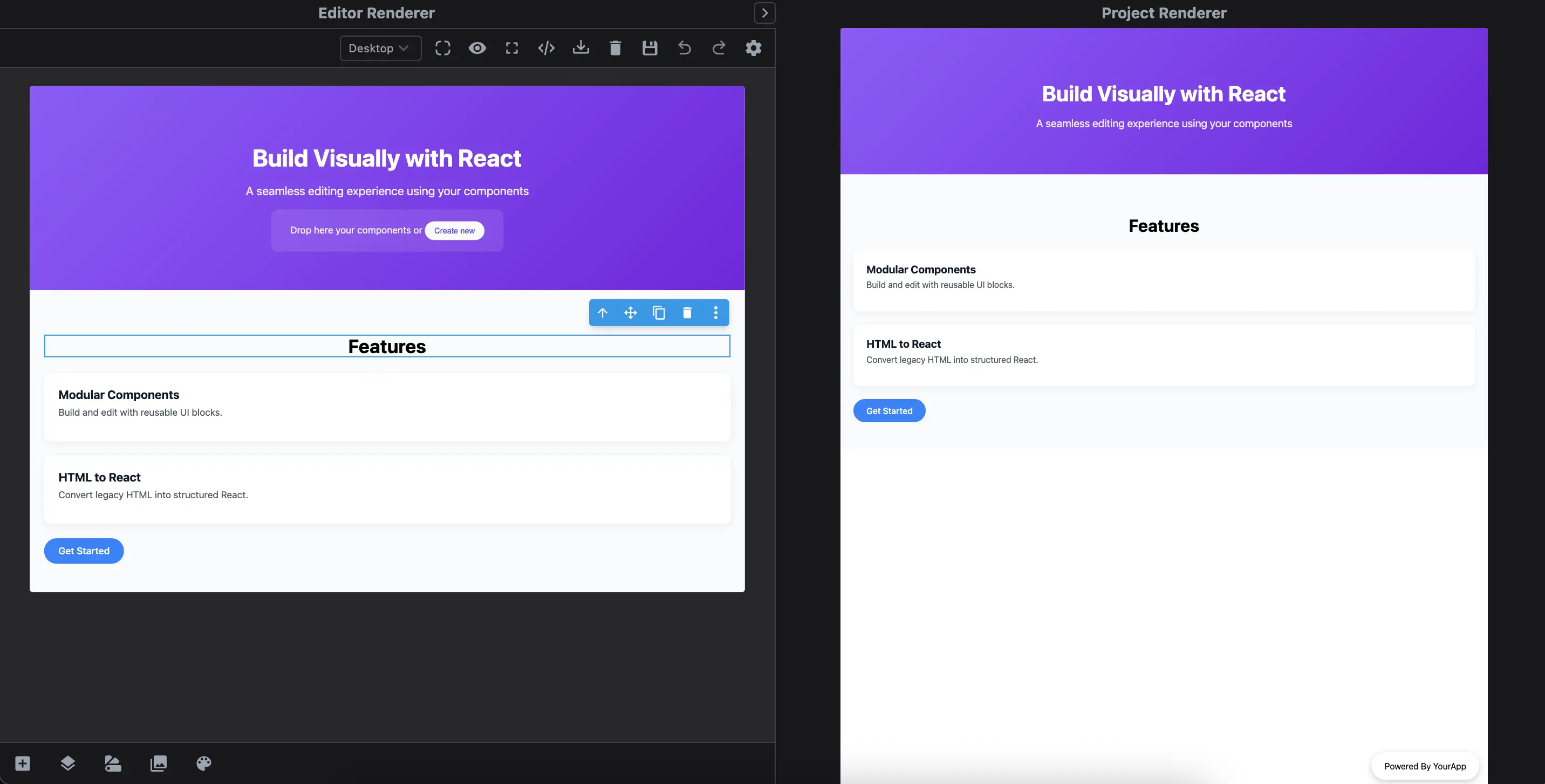React Rendering Comes to Studio SDK ⚛️
We’re thrilled to announce a powerful new addition to the Studio SDK plugin ecosystem: the React Renderer plugin.
This marks a major milestone for developers building component-driven applications and wanting visual editing capabilities that speak the same language as their frontends.
Whether you're running Next.js or shipping a custom component library, Studio SDK now gives you direct visual editing of React components.
What This Unlocks
The new react renderer plugin allows you to:
- 🔁 Replace the default HTML canvas with a React renderer
- 🧱 Use your own React components inside the editor
- ✍️ Add Pages and Blocks using JSX or HTML, auto-parsed into React elements
- 🖥️ Render entire saved projects with a React component—even with SSR
This isn’t just a minor enhancement. It’s a paradigm shift for how Grapes JS, both our studio and OS offering, integrates into modern app stacks.
Why React Rendering?
Component-based frameworks are the default for modern web UIs. Until now, visual editing platforms struggled to cleanly support those workflows.
With the React Renderer plugin, your React components can now be used in Grapes Studio, but also installed as a plugin into the Open Source version of GrapesJS:
- Use props, slots, and events natively
- Preserve styling and interactivity
- Maintain one codebase across design and production
This means you can finally bridge the gap between developer-authored components and user-generated content—without losing structure, performance, or flexibility.
How It Works
Here’s a quick overview of how to get started.
Import the plugin:
import StudioEditor from '@grapesjs/studio-sdk/react';
import '@grapesjs/studio-sdk/style';
// Import React renderer plugin
import rendererReact from '@grapesjs/studio-sdk-plugins/dist/rendererReact';
Now you can define your components:
const reactRendererConfig = {
components: {
Hero: {
component: Hero,
props: () => [
{
type: 'text',
name: 'title',
label: 'Title'
},
{
type: 'text',
name: 'subtitle',
label: 'Subtitle',
value: 'Default Subtitle'
}
],
},
}
};
Now initalize the editor:
<StudioEditor
options={{
plugins: [
rendererReact.init(reactRendererConfig),
(editor) => {
editor.Blocks.add('feature', {
label: 'Feature component',
category: 'React',
full: true,
content: <Feature title="Feature title" description="Feature description" />
}, { at: 0 });
}
],
project: {
type: 'react',
default: {
pages: [
{
name: 'Page from React',
component: (
<>
<Hero title="Build Visually with React" subtitle="A seamless editing experience using your components"/>
<Section>
<h2 data-gjs-type="heading" style={{ textAlign: 'center', fontSize: '2rem' }}>Features</h2>
<Feature title="Modular Components" description="Build and edit with reusable UI blocks." />
<Feature title="HTML to React" description="Convert legacy HTML into structured React." />
<Button label="Get Started" href="#start" />
</Section>
</>
)
},
{
name: 'Page from HTML',
component: `
<h1>React Components from HTML</h1>
<div data-gjs-type="Hero" title="React from HTML"></div>
<style>
body { font-family: system-ui; }
</style>
`
}
]
}
},
}}
/>
Ideal Use Cases
This plugin is perfect for teams that:
- Are building custom design systems or white-labeled page builders
- Want to re-use production React components in a WYSIWYG context
- Need server-side rendering (SSR) for React content
- Are replacing legacy CMS editors with dynamic React-based editing
- Want to provide live previews of marketing components, modals, or dashboards
No more exporting HTML and trying to parse it back into components. Now, your content pipeline stays React-native from start to finish.
SSR, Frameworks, and Flexibility
The React Renderer supports both client-side rendering and server-side rendering, making it ideal for Next.js, Remix, or other SSR-first frameworks.
Projects can be saved as JSON and later rendered wherever needed—landing pages, email previews, admin dashboards—using your actual app components.
Final Thoughts
This is a major step forward for Studio SDK, especially for teams who live in React. With this new plugin:
- You get full visual editing of your own components
- You can render pages anywhere using structured, component-safe data
- You can create smarter, more maintainable editors without duplication
It's visual editing, the React way.
⚛️ Explore the React Renderer Plugin Docs
🍇 Happy Building!

